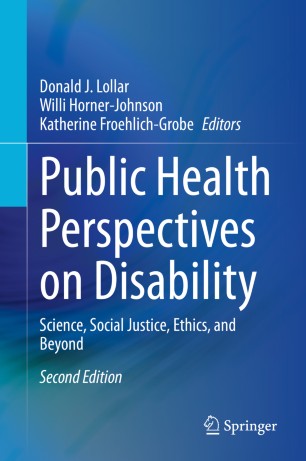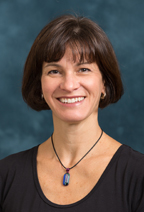Shining a light on public health and people aging with disabilities in new book
Philippa Clarke, Clive D'Souza, and Michelle Meade contribute a chapter titled, “Aging with a Disability” in the recently published book, Public Health Perspectives on Disability: Science, Social Justice, Ethics and Beyond.
The number of older adults in the United States is growing rapidly. Previous research from 2017 estimates that every day from now until 2030, approximately 10,000 adults in the U.S. will turn 65. Some of these individuals will develop a disability that may include a visual impairment, hearing loss, dementia, osteoarthritis and/or another chronic health condition, while others will age with an early-onset disability.
Public health needs to be equipped to handle the challenges of those aging with a disability and to influence effective policy change, according to experts at the University of Michigan and Michigan Medicine.
To make up for the dearth of information, a small team of faculty from the Center for Disability Health and Wellness contributed a chapter titled, “Aging with a Disability” in the recently published book, Public Health Perspectives on Disability: Science, Social Justice, Ethics and Beyond.
Authors include Center for Disability Health and Wellness members Philippa Clarke, Ph.D., professor of epidemiology in the School of Public Health; Erica Twardzik, Ph.D. a former student in the School of Public Health and School of Kinesiology; Clive D’Souza, Ph.D., assistant professor of Industrial and Operations Engineering in the College of Engineering; and Michelle Meade, Ph.D., professor in the Department of Physical Medicine and Rehabilitation at Michigan Medicine.
“Policy makers were beginning to see the impact or the potential impact of the growing number of people aging with a disability” about 10 years ago, said Clarke, who is the chapter’s lead author.
Despite this early recognition, not much has changed in public health to take into consideration the needs and requirements of those aging with a disability when it comes to living and aging healthfully.
Clarke said that people with disabilities face not only issues of ableism, but also ageism. This may lead to a greater risk of discrimination and marginalization. Policies already established to accommodate the aging population may inadvertently exclude aging individuals with a disability. Clarke raises a caution against policies that segregate the two.
“The field of public health and policy makers are grappling with these issues,” she said. “You can’t apply an aging framework with people who are aging with disabilities. Their needs are going to be far greater.”
Clarke said that the study of disability, including those aging with a disability, needs to be integrated in the curriculum in public health schools.
“We really don’t discuss disability in our schools of public health,” she said. Certainly, at University of Michigan “there are no classes on disability in public health. It’s absolutely an egregious error,” she added.
Clarke et al’s chapter discusses various topics including:
Conceptual and theoretical frameworks pertinent to those aging with a disability.
- The role of technology and its development in supporting an older individual with a disability in a healthy aging process.
- The development of transportation technology and promotion of mobility for those aging with a disability.
- The environmental and community requirements to promote healthy aging for the older person with a disability.
“These were topics that are not part of the regular discourse in aging with a disability and they were the things we thought should be discussed,” Clarke said. “This textbook is designed to get the message out that disability is part of public health.”
She added that all of those who study and/or are employed in the public health professions need to know what disability is, what it means to age with a disability, and the heterogeneity of this population.
Clarke, who defines herself as a social gerontologist, says she’s always been interested in studying the ageing process and how disabilities impact that process. She’s motivated by the fact that her mother lived with multiple sclerosis.
“I bring a lens of trying to understand aging and I was recently introduced to the idea of the different populations who are aging with a disability,” she said. “What are the unique ways that the environment affects those aging with disabilities?”
Clarke mentions that her fellow author Twardzik is a doctoral student in epidemiology in the School of Public Health. Though the school doesn’t offer curriculum about aging with a disability, Clarke always tries to discuss the subject with her students. Additionally, she would like develop a course in epidemiology and public health as it relates to disabilities.
She added that she found it inspiring to work with Clive D’Souza who brings in an engineering background and Michelle Meade, who is co-director of the CDHW.
“The work that Clive does is so inspiring. He thinks about things like buses and bus design. He does much more applied work as far as making changes while my work is more observational,” she said. “Michelle is a visionary and a leader at the university and in the country in drawing attention to disability and the barriers faced by people with disabilities in our society. She has such motivation and energy.”
Drs. Clarke and Meade are serve as Co-Principal Investigators for the IDEAL Rehabilitation Research and Training Center (RRTC) at the University of Michigan.
Book Citation: Lollar, D. J., Horner-Johnson, W., & Froehlich-Grobe, K. (Eds.). (2020). Public Health Perspectives on Disability: Science, Social Justice, Ethics, and Beyond. S.l.: SPRINGER-VERLAG NEW YORK. doi: 10.1007/978-1-0716-0888-3.


